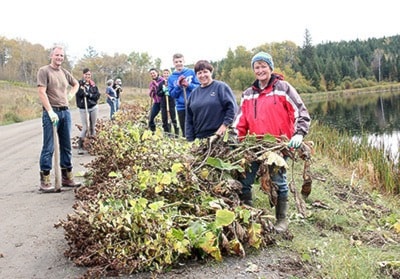A $1.16-million job-creation project developed by the provincial government and the Invasive Species Council of British Columbia (ISCBC) is putting people to work weeding out invasive plants and species in five Interior communities, including the 100 Mile House area.
The three-person team assigned to each community will focus on the invasive species present in that specific area. They will gain skills in conducting field inventories, surveying, plant identification, data recording, data management and communications.
After participants survey and then remediate invasive species populations, they work to raise public awareness of the issue with various groups and at community events.
A Community Weed Pull project was undertaken at Hall Lake on Back Valley Road on Sept. 9-10.
Crews from 100 Mile House and Williams Lake helped area residents remove many millions of burdock seeds (each plant produces between 6,000 and 16,000 seeds).
The burdock plants, which were choking out native plant species along the bank of Hall Lake, had to be dug out out of the ground to remove the tap root.
From there, the plants were taken to the landfill and buried under layers of dirt.
It is important to remove the plants before the seeds are matured.
This was the second year area residents have removed burdock plants from the Hall Lake banks, and the volunteers say the plant numbers were significantly reduced this year.
The hope is to completely remove the burdock plants, which are a growing threat to the agriculture land along the road.
